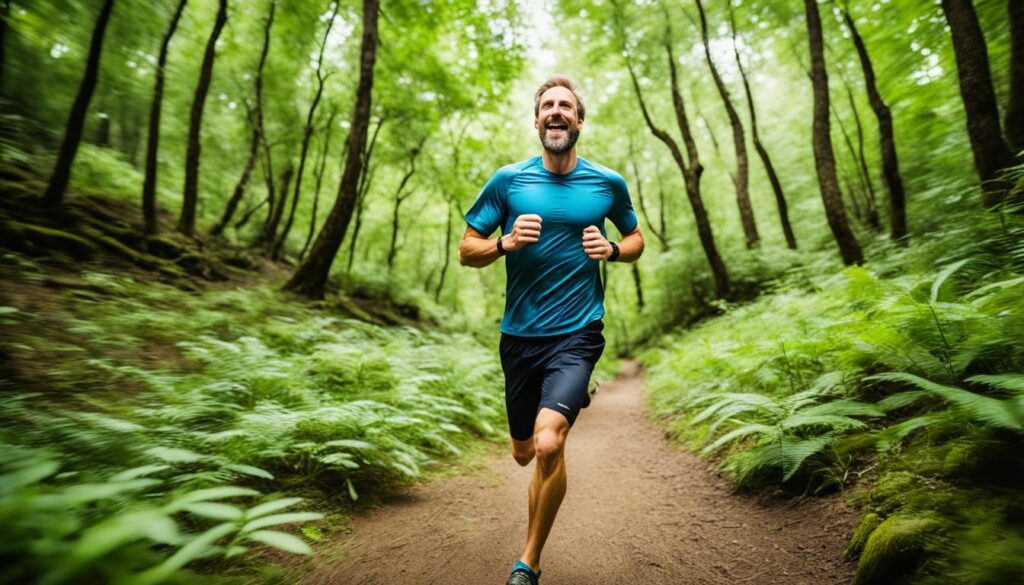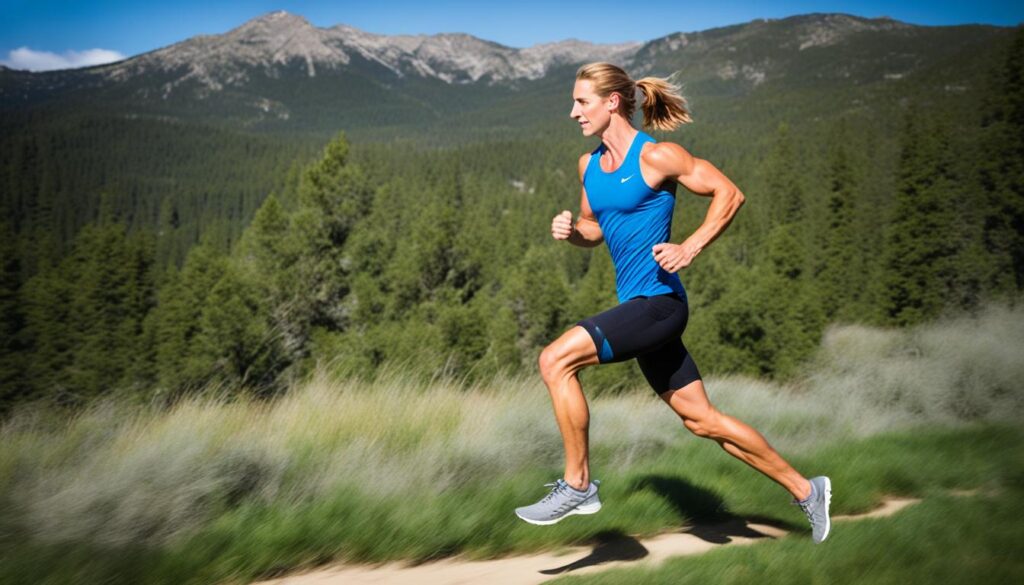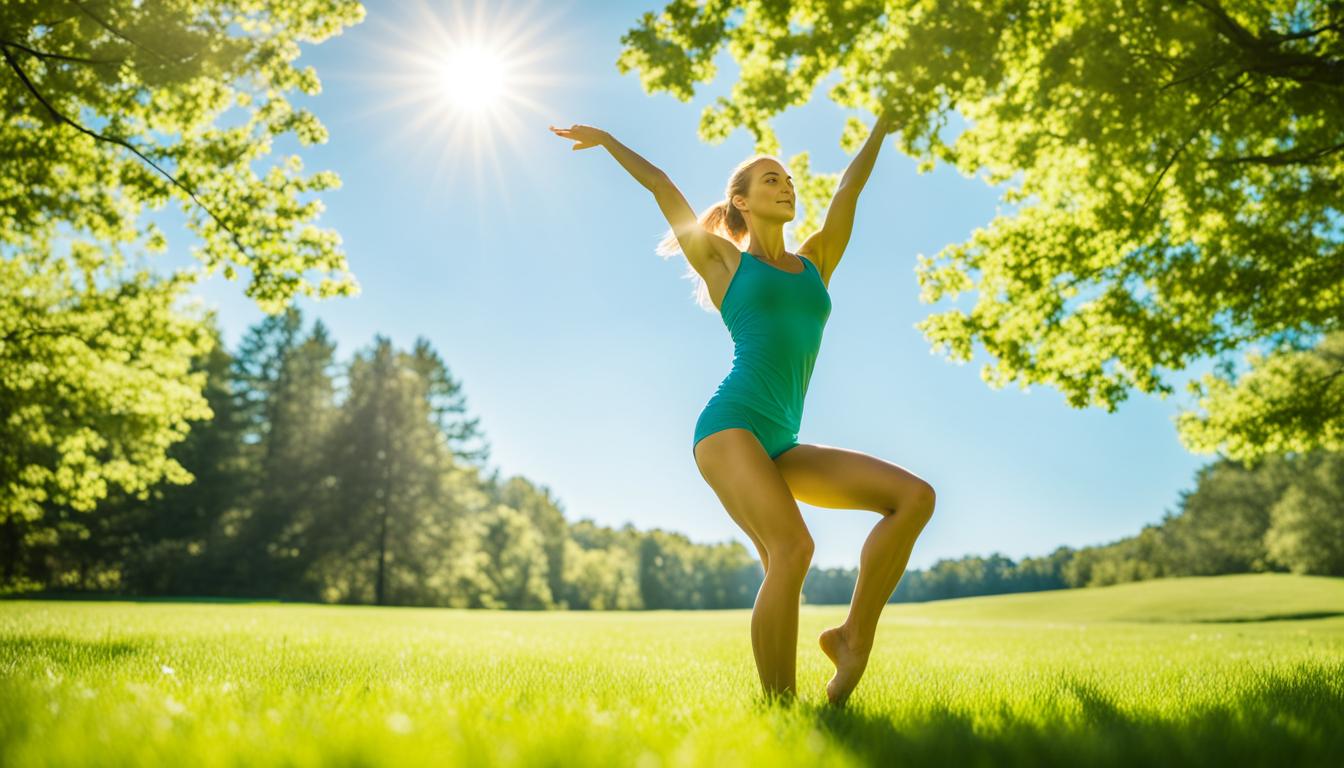In our world filled with high-tech sneakers, it might surprise you that millions are going barefoot for their runs. Barefoot running is more than a trend; it’s growing in popularity. This guide helps you learn running barefoot. It’s like following in our ancestors’ footsteps. They knew all about moving without shoes. As you read this guide, you’ll start mastering barefoot running. You’ll make a safe shift from cushioned shoes to feeling the earth under your feet.
Key Takeaways
- Millions have embraced learning to run barefoot, getting back to a natural running form.
- Switching to barefoot running can improve agility and strengthen your connection with the environment.
- This full guide shows you how to run barefoot safely and effectively.
- Starting this practice requires understanding the right techniques and benefits, aiming for healthy running and less injury.
- Running without shoes is a journey to our origins, and now we have modern insights to support it.
- Get ready to join a community of runners who have discovered freedom and better performance in the barefoot way.
Embracing the Barefoot Running Movement
The surge of interest in the barefoot running movement isn’t just a trend. It marks a return to our origins. It promotes a natural running form that helped our ancestors move quickly and securely. Before the era of modern footwear, this was the way. As we remove the padding and rigid structures, we embrace the world beneath our feet. We also tap into the insights our bodies want to share.
Understanding the Shift Towards Natural Running Form
In recent years, a change has swept over the running community worldwide. Runners are adopting simplicity and authenticity. The barefoot running movement is about more than just running without shoes. It’s a wholesome journey to wellness that respects our body’s design. By choosing minimalist running, fans find that less really can be more.
Embracing our natural running form strengthens and flexes our feet. It also reconnects us with the ground. This change fulfills a longing to be one with nature like our ancestors. It also offers clear benefits for modern runners who strive for balance and efficiency in their movement.

The Historical Perspective of Running Without Shoes
Long before high-tech sneakers, humans mastered the art of running barefoot. This ancient skill informs today’s barefoot running ideals. Initially, footwear was for protection from harsh surfaces, not improving athletic performance.
Anthropological research shows that modern shoes might lead us away from our best way of moving. In many cultures, running barefoot was essential, a skill to be mastered. The current barefoot movement is about rediscovering this skill. It means unlearning bad habits to revive our innate capabilities.
The barefoot running movement also brings up important health discussions. We’re now exploring the benefits and science of running naturally.
The Compelling Benefits of Barefoot Running
Running without shoes is more than a practice. It revives our body’s natural skills. It offers perks that attract more and more runners worldwide. Looking into benefits of barefoot running, we discover it boosts our body’s workings. It also deepens our connection with the ground.
Preventing Injuries Through Natural Gait
Barefoot running shines in preventing injuries common to runners. It promotes a natural way of moving. Runners land softer, on the mid-foot or forefoot. This spread of impact is safer.
This contrasts with the hard heel strike from wearing shoes. That approach sends harmful shock through the body. It can cause lasting injuries.
Toe Strength and Balance Enhancement
Toe strength grows in barefoot runners. This is key for staying upright and balanced. Toes move more when not in regular shoes. This firms up muscles in feet and legs. It makes us agile and steady, which is good for running and other daily tasks.
Neurological Stimulation for Improved Balance
Running shoeless also boosts neurological stimulation. Our feet’s soles are full of nerve endings. They send signals to our brain. Barefoot, these signals make our brains brighten up. They update our balance and movement. This helps us move more safely and efficiently.
In the vast world of running, going shoeless brings a special depth of experience. It makes our toes stronger, keeps us from getting hurt, and sharpens our brain’s control over balance. Barefoot running stands out as a full approach to unleashing our natural power. Each step on the ground is a step toward health and balance. We move forward freely and strongly.
How to Run Barefoot: Your First Steps
Starting your journey into barefoot running means learning how to run barefoot in a way that’s good for your body and love for running. Moving away from regular shoes takes steps that get your feet ready for new feelings. This approach prepares your feet step by step.
Running barefoot safely is very important. That means you should start slowly. Let’s look at some barefoot running tips that will help you begin confidently.
Acclimate Your Feet: Start by going barefoot at home. This lets your feet get used to different textures and temperatures. It builds sensitivity and strength for outside.
Practice on Soft Surfaces: Begin on soft grounds like sand or grass. These kinds are easy on your feet and let them adjust safely.
Focus on Form: Learn the right way to run. Keep your steps short and stand tall. Touch down gently on your midfoot or forefoot, not your heel.
Selecting Minimalist Shoes: If going straight to barefoot is hard, try minimalist shoes. They offer a close-to-barefoot feel with a bit of protection.
The table below is a starter plan for new barefoot runners. Following it week by week helps get your feet and body ready for full barefoot running.
| Week | Activity | Duration | Focus Area |
|---|---|---|---|
| 1 | Barefoot walking indoors | 15–30 minutes daily | Foot acclimation |
| 2 | Barefoot walking outdoors (soft terrain) | 10–20 minutes daily | Terrain adaptation |
| 3 | Short barefoot runs (soft terrain) | 5–10 minutes every other day | Form and impact adjustment |
| 4 | Introduction to minimalist shoes (mixed terrain) | 15–30 minutes every other day | Transition to varied terrains |
| 5 | Increase barefoot or minimalist shoe running duration | Gradually add 5 minutes to each session | Endurance building |
Remember: Transitioning to barefoot running is not a race. Listen to your body, and progress at a pace that feels right for you. The journey towards improved health and efficiency on your running path should be both enjoyable and free from injury.
With patience and following these guidelines, you’ll learn how to run barefoot easily. You’ll enjoy the benefits of this natural and refreshing way of running.
Refining Your Barefoot Running Technique
Starting your journey to improve your barefoot running technique means paying attention to how your body moves. It also means being ready to change. Good posture is key for running well without shoes. Imagine a line going straight up from the top of your head. This helps line up your spine and keeps you balanced while running. Keeping your shoulders relaxed is also crucial for finding that natural running form.
Think of your body parts working together as you run. Your feet do the hard work, and your breathing sets the pace. Deep and steady breaths do more than just fill the background. They power your steps and energize your muscles. To get better at running naturally, watch how your feet hit the ground. Your foot strike affects everything from how your body lines up to how you breathe and use your muscles.
To get better at running barefoot, look for advice that supports moving naturally. For example, Chi Running courses focus on alignment and being relaxed while running. These ideas go well with what’s important for running without shoes.
Here’s a quick guide to remember as you start running barefoot:
- Maintain a Straight Torso: Keep your upper body straight to avoid strains and stay stable.
- Relax Your Shoulders: Loosening your shoulders helps your arms swing better and cuts down on tiredness.
- Deep Breathing: Breathing deeply and in a rhythm helps get more oxygen and makes running feel calming.
- Natural Foot Strike: Touch down gently on the middle or front of your foot for efficient impact handling.
- Professional Guidance: Use expert tips to make your progress smoother and more effective.
Switching to running barefoot takes time. Be kind to yourself and patient as your body gets used to it. As you improve, every step will show the freedom and happiness that comes with this kind of running.

Switching from Regular Running Shoes to Barefoot Running
For many runners, changing from traditional running shoes to barefoot running is a big shift. It offers a new way to feel movement and understand the ground. Going for minimal shoes or no shoes means paying close attention. It also means respecting how your body gets used to new challenges.
Starting with the Proper Footwear
Choosing the right shoes is key to moving to a barefoot style. Look for minimalist shoes that allow natural toe movement, a flexible sole, and no heel raise. These features help you adapt smoothly. Starting with these shoes can make the transition easier and teach your feet about freedom and responsibility.
Adjusting Your Stride and Posture
Changing how you walk and stand is also important when switching to barefoot running. Aim for landing on the middle part of your foot. Use your toes for better control and keep your back straight for efficient energy use. Avoiding long strides will help decrease calf stress and lower injury risks.
- Ankle alignment in relation to stride
- Engagement of toes upon foot strike
- Body posture during movement
Experienced runners often say to listen to your body and be patient. Switching to barefoot running is not about speed. It’s about enjoying a freer way to run.
| Feature | Barefoot Running Benefit |
|---|---|
| Wide Toe Box | Promotes natural toe splay |
| Flexible Sole | Encourages foot’s natural movement |
| Zero Drop | Aligns posture and reduces heel impact |
When you start barefoot running, it’s not just changing shoes. It’s about improving how you run naturally. This journey is very freeing. As you move to barefoot running, go slowly and be proud of small wins.
Choosing Footwear for Barefoot Running
Starting barefoot running means finding the right shoes. This choice impacts your comfort, how well you perform, and how long you can keep running barefoot. Look for features in minimalist running shoes that are top quality.
Key Features of the Perfect Barefoot Running Shoe
Finding the best shoe combines protection with feeling free. Focus on these important features:
- A wide toe box allows for unrestricted toe movement, enabling a natural toe spread.
- Flexible soles that bend and move with the feet’s natural flexion and extension.
- A zero-drop heel design maintains your foot at a flat, even level, promoting a more natural posture and alignment.
- Lightweight materials ensure the shoe doesn’t add unnecessary weight, allowing for agile movements.
- Breathable fabric to help with temperature regulation and comfort during long runs.
What to Look for in Minimalist Running Shoes
While you start with key features, picking the right minimalist shoes needs more insight:
- Consider your typical running terrain and choose shoes with appropriate outsole protection to guard against hazards without dampening ground feel.
- Ensure there is enough space in the toe box to prevent compression, as a cramped fit can lead to discomfort and inhibit natural movement.
- Opt for shoes with a secure fit around the midfoot to prevent sliding while allowing for natural arch movement.
- Look for durable, quality materials that withstand the wear and tear of your running surface, whether it’s urban pavements or rural trails.
- Select shoes with removable insoles to customize the level of support and cushioning based on your transition progress and preference.
Choosing minimalist running shoes is not just simple. With the right knowledge and paying attention to what you need, you can make running barefoot a great experience.
Conditioning Your Body for Barefoot Running
Starting to run barefoot means getting your mind and body ready. It’s important to strengthen your body to prevent injuries and improve your running. Focusing on a strong core and feet makes a huge impact.
Strengthening Exercises for Your Feet and Calves
Foot strengthening exercises are key to avoid injuries in barefoot running. Toe curls, heel walks, and calf raises help build muscle. These prepare your feet and calves for running without shoes.
- Toe Rises: Strengthen the muscles around the balls of your feet, essential for stability.
- Balance Workouts: Engage and train your intrinsic foot muscles for better proprioception.
- Soft Jumps: Improve calf muscular endurance and resilience, reducing fatigue during runs.
Staying consistent with these exercises prepares your feet for barefoot running and reduces injury risk. It helps you run more efficiently.
Incorporating Core Workouts to Support Barefoot Running
It’s crucial to work on your core as well. A strong core keeps you stable while running barefoot. Balance and posture are very important, and core workouts help with these. They improve your performance and prevent injuries.
| Exercise | Core Muscles Targeted | Benefits for Barefoot Running |
|---|---|---|
| Planks | Transversus Abdominis, Multifidus | Develops stability and body alignment |
| Side Planks | Obliques, Gluteus Medius | Enhances lateral strength crucial for balance |
| Pilates 100s | Transversus Abdominis, Pelvic Floor | Improves breathing control and postural endurance |
| Bird Dog | Erector Spinae, Glutes | Trains cross-body connections needed for gait symmetry |
It’s important to start slow. Your muscles need time to get used to new demands. Combining foot and core exercises is crucial for your success in barefoot running. It’s a big part of keeping you healthy and performing your best.
Overcoming Challenges and Prioritizing Safety
Barefoot running offers freedom but also presents unique challenges. Knowing common hurdles and ways to handle them improves your experience. Learning how to avoid injuries and tackle different terrains is key for any barefoot runner who wants the best from their runs.
Identifying and Preventing Common Barefoot Running Injuries
To avoid barefoot running problems, start with prevention. It’s crucial to recognize common injuries like Achilles tendinitis and plantar fasciitis. These often happen from overusing your feet or wrong technique. By slowly increasing your distance and adapting your technique, you can lower injury risks. Here’s a table of usual injuries and how to prevent them:
| Injury | Symptoms | Prevention |
|---|---|---|
| Achilles Tendinitis | Pain along the Achilles tendon during and after runs | Gradually increase distance; focus on calf flexibility |
| Plantar Fasciitis | Sharp heel pain, particularly in the mornings | Strengthen arch and foot muscles; proper warm-up |
| Metatarsal Stress Fractures | Swelling and pain in the forefoot, worsened by activity | Avoid sudden mileage increase; use appropriate footwear |
Navigating Different Terrains and Weather Conditions
Mastering terrains involves technique and perception. Weather and landscapes offer challenges, like icy or hot paths. Skillfully adapting your technique for the ground improves safety and the barefoot running experience. Knowing the terrain, choosing the right shoes, and wearing suitable gear are crucial for a safe, enjoyable run.
- Smooth Pavement: It’s predictable, making it good for beginners. Yet, always watch for debris.
- Grass: A soft surface that can hide dangers. Use quick, light steps to avoid injury.
- Trails: They are uneven and need more attention and special shoes for protection.
- Beach: Running in sand is hard but rewarding with beautiful views. Perfect your technique here.
For new and experienced barefoot runners alike, preventing injuries and handling different terrains are crucial. With knowledge and careful preparation, you can face barefoot running challenges confidently. Keep prioritizing your safety with every step you take.
Conclusion
The journey of mastering barefoot running is just starting for many. The benefits are significant, like preventing injuries with a healthier walk. It also includes strengthening feet for better support and aligning your body correctly. By taking part in the barefoot movement, you join others who enjoy the simplicity of running barefoot. This isn’t just about physical benefits. It’s also about feeling deeply connected with the natural world around us.
We’ve talked a lot about transitioning carefully and listening to your body. If you’re new to running without shoes or thinking about trying it, remember to be patient. The change won’t happen overnight. But as your feet get used to different grounds and feelings, you’ll experience a new kind of freedom. The kind that tight shoes can’t offer.
Now you know how to run properly, pick the best minimalist shoes, and get your body ready. You’re all set to confidently walk this new path. Welcome the incredible feeling of connecting with the earth under your feet. Look forward to the new adventures and the natural rhythm of your steps. May every part of your barefoot running experience bring you joy. Keep living the true spirit of this lifestyle.

